Daft Punk’s Discovery Synth Sounds

Yesterday, Daft Punk announced that they were calling it quits after 28 years. Their legendary career gave us four groundbreaking studio albums, the Tron: Legacy soundtrack, two movies and two classic live albums. For this article, I wanted to pay tribute to my personal favourite Daft Punk album, and the one that started my fascination with electronic music in the first place, Discovery.
Although Discovery is most famous for the creative use of chopped and looped samples on singles like One More Time and Harder, Better, Faster, Stronger, there are also plenty of synth-driven tracks. The duo had amassed an enviable synth collection at this point but still relied on the most-used synth, the Roland Juno-106. This article features my remakes of the songs Voyager, Short Circuit, Veridis Quo and Aerodynamic and deconstruct the synth sounds behind them.
As always, all the TAL U-NO-LX and Arturia V Collection presets featured in the remakes are available for free download at the end of the article. Enjoy!
Daft Punk Synths
For early live shows, Daft Punk would utilise LinnDrum and Roland TR-909 drum machines alongside a Roland Juno-106 and TB-303 for synths. In a 2001 interview with the French Keyboard magazine, Daft Punk listed the following pieces of gear used on Discovery:
- Synthesizers:
- Roland Juno-106
- Roland Super Jupiter
- Minimoog
- SC Prophet 600
- SC Prophet VS
- Korg Poly Ensemble
- Samplers:
- E-mu SP-1200
- E-mu Emulator III
- Ensoniq ASR-10
- Ensoniq ASR-X
- Roland S-760
- Akai MPC3000
- Drum Machines:
- Roland TR-808
- Roland TR-909
- LinnDrum 9000
- Linndrum LM1
- Sequential Circuits Drumtraks
Whereas a large part of Homework, Daft Punk’s debut album, was crafted of samples of funk and soul records, Discovery saw them experiment more with recording their own samples. The following quote perfectly sums up their approach:
“In at least one instance on Discovery, Daft Punk used a vintage keyboard to evoke a specific artist from another era. “On ‘Digital Love,’ you get this Supertramp vibe on the bridge,” remarks de Homem-Christo. “We didn’t sample Supertramp, but we had the original Wurlitzer piano they used, so we thought it would be more fun to have the original instrument and mess around with it.”

Voyager
Voyager is a straightforward French House track built around a lush 4-bar chord sequence over a funky bassline and four-to-the-floor drums. There’s no vocal line or main melody but the track works because it just feels good.
The main chord sound in Voyager was likely recorded on the Roland Juno-106 which Daft Punk had been using live since as early as 1995 as well as on the Homework. To recreate the Voyager synth sound I’ve used TAL U-NO-LX, a software emulation of the Roland Juno synths.
The patch uses the sawtooth oscillator with both filters (high-pass and low-pass) set to halfway, resulting in a mid-range focused sound. The filter envelope is set to 2.7 with the ADSR envelope set up with an attack of 4, decay of 7 and no sustain which adds some movement to the sound. The Juno’s onboard chorus effect is a big part of its sound, so turn on the Chorus II effect.
The Juno synth pad is layered with some background strings which can be heard most clearly at 2:08. For this sound, I used the Omnisphere preset Adagio Expressivo which uses samples of real strings. Daft Punk likely used a sample-based Romper hardware synth for this track.
- Juno Pad 00:00
- Sampled Strings 00:00
- Voyager Layered 00:00
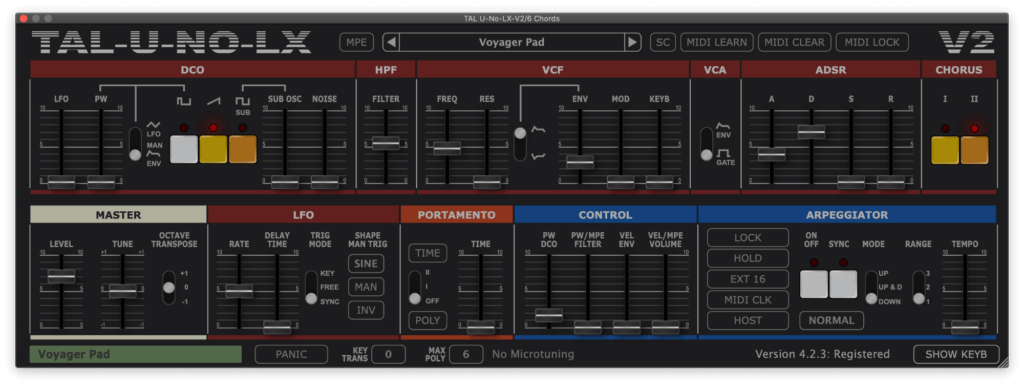
The super-funky bass line is the highlight of Voyager and sounds like another use of the Roland Juno-106. The MIDI programming on the bassline itself is very detailed, making use of 32nd note lengths for short funky notes. The key to programming the sound on a synth is to set the filter resonance high and find the cutoff sweet spot. In TAL U-NO-LX, set the filter frequency to 3.26 and the resonance to 6.89. Set the envelope amount to 1.71 with an ADSR decay setting of 5.72 and no sustain.
Lastly, turn the ‘KEYB’ fader to 0, this will disable filter keyboard tracking, ensuring that the filter cutoff point will stay the same across the keyboard.
- Juno Bass 00:00
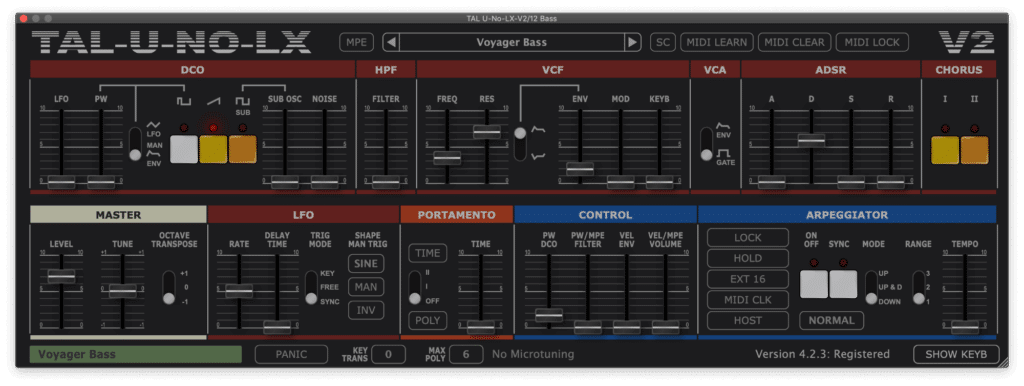
The outro introduces a harp-like arpeggio sound which would have come from a digital synth, in contrast to the analog Juno sounds we’ve looked at so far. The sound is a DX7 harp, however, it’s more than likely that Daft Punk used a sampler containing the ubiquitous DX7 sounds. For my remake, I used Arturia’s DX7 V softsynth on the factory preset Rom1B 30-Harp 2, which to my ears sounds just like the sound at the end of Voyager. Judge for yourself:
- DX7 Harp 00:00
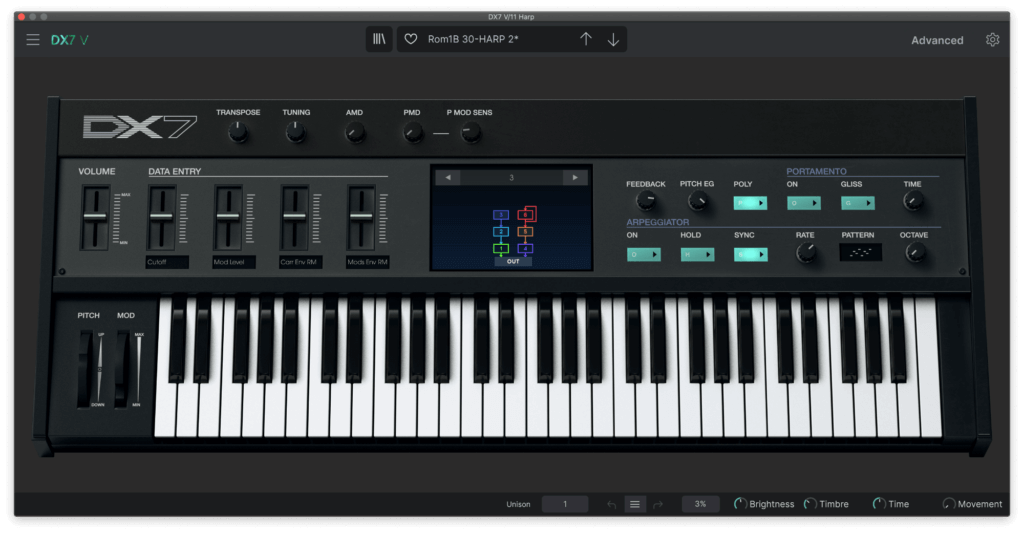
Below you can check out my full remake of Voyager using all of these remade sounds. There are three funky background guitar loops, these were likely recorded by Daft Punk and instead of being sampled from a record or sample CD. Production-wise there’s a light phaser on the chords and Daft Punk’s signature sidechain compression on the main instrument bus triggered by the kick drum.
Short Circuit
Short Circuit is based around two sections, the first has a chopped-up feel and was likely created by sequencing pre-recorded synth samples. The outro features woozy synth chords with a Ryuichi Sakamoto vibe that gradually become more distorted before the song fades out.
The main synth in Short Circuit sounds like the Roland Juno-106 again, possibly with a Roland TB-303 for the classic acid bass part. The first patch has a wide, fast vibrato that comes in after a short delay. In TAL U-NO-LX this is done by setting the LFO rate to 7.24 Hz and nudging the delay time up slightly to 0.05. Setting the LFO trigger mode to KEY will help make the LFO effect sound more consistent, as it restarts it from the same place on every note or chords.
Set the DCO’s LFO fader (at the top left) to a high 6.5. This results in a slightly delayed super-wide vibrato, so program short, funky notes for this patch. Here’s what it sounds like:
- Short Circuit Main Juno 00:00

There’s also a swell patch that can easily be created by setting a filter envelope with a long attack. The patch uses a single sawtooth oscillator and the filter settings in TAL U-NO-LX are frequency of 3.5, resonance of 3.8, envelope of 5 and attack time of 7.2.
- Short Circuit Swell 00:00
There are two bass synths in Short Circuit, the first plays underneath the main vibrato chord stabs and can be created in TAL U-NO-LX with a mix of the sawtooth and full sub oscillators. Set filter cutoff to 3, resonance to 5 and envelope amount to 4.6 with attack and decay around 3 and no sustain. The 2nd bass patch is the resonant sound that comes in 30 seconds into the song. For this sound, use the sawtooth wave with the sub-oscillator volume at 7.5 You could also get great results recreating this sound using a TB-303 emulation.
- Bass 1 00:00
- Bass 2 00:00
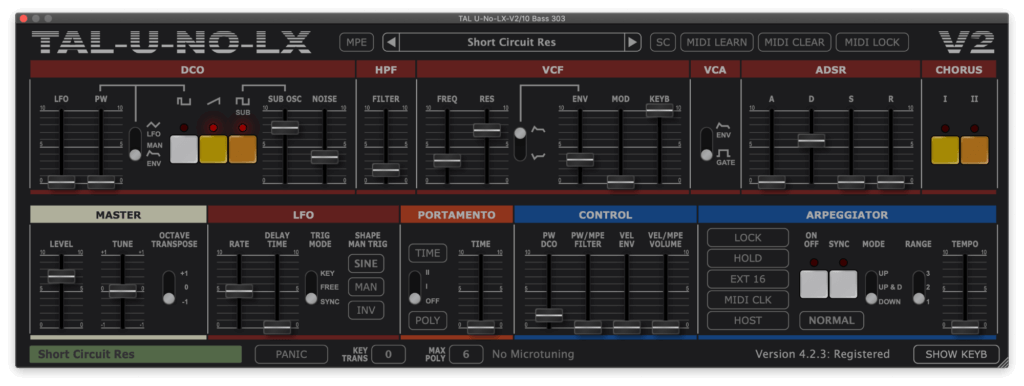
The outro patch uses the Juno square wave oscillator in LFO mode with the PW fader set to halfway. There’s slow LFO pitch vibrato on this patch which creates the distinctive lo-fi woozy sound. Set the LFO fader in the DCO section to 2 and the LFO section’s rate fader to 2.28 Hz with Trig Mode set to Free. The filter is set up with a long envelope decay and a medium amount of resonance. I also found setting keyboard tracking to halfway helped in recreating the sound closely.
For this patch the Chorus I effect is on, however, the original sound is completely mono. You can record the Juno-106 in mono by simply only using one of the outputs. For TAL U-NO-LX you can get the same effect but placing a Utility effect after the synth that will pass only the left or right channel. Daft Punk likely recorded their Juno-106 using only one of the two outputs for the mono sound.
- Outro Juno 00:00
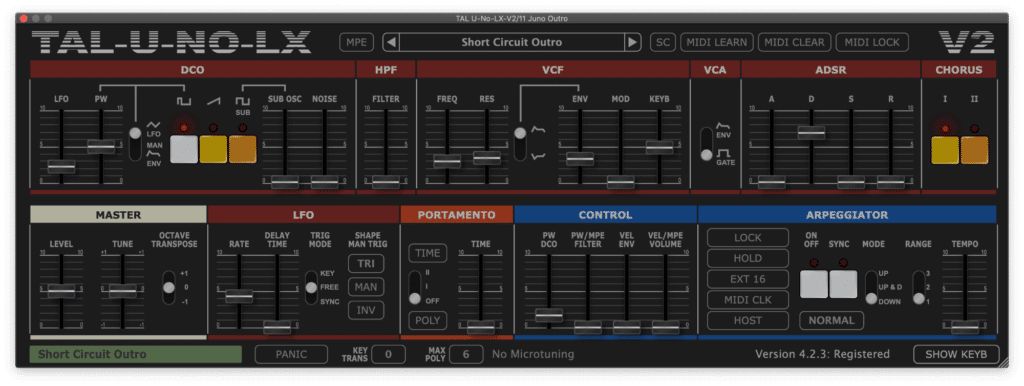
Veridis Quo
The title of Veridis Quo is a play on the albums primary influence: “very disco”, which is also played on by the album title: “discovery”. Veridis Quo has a distinct baroque-inspired harmony with some layered flutes providing the main melody. The flute sound is the Yamaha DX7 factory preset Rom2A 02-Flute 2 and the chord sound beneath it is Rom1B 17-Pipes 2. The DX7 isn’t on any gear list mentioned by Daft Punk in interviews, so it’s likely they used sampler patches of these classic DX7 sounds. Here’s what both presets sound like using Arturia DX7 V:
- DX7 Flute 2 00:00
- DX7 Harmonized 00:00
- DX7 Pipes 2 00:00
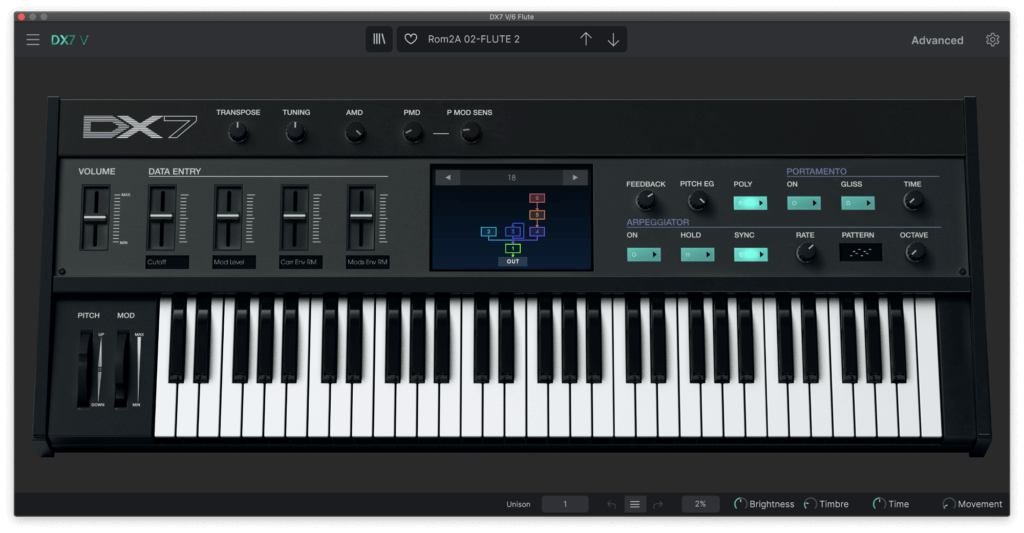
There’s also a phaser pad in the mix that is introduced around halfway through the song. Daft Punk were using AMS Phasers and Ensoniq DP4 multi-effects box for Discovery; unfortunately neither has been remade as a plugin so I recreated the sound using the Softube Fix Phaser plugin. Here’s the synth sound, with and without the phaser effect.
- Synth Phaser 00:00
- Synth Dry 00:00

The arp patch is a simple sound that uses a short decay/release time to create an almost percussive effect along with high resonance for an acid feel. The filter slowly opens and closes as the song plays which was likely done by manually moving the filter cutoff frequency fader while recording the track.
- Verdis Quo Arp 00:00

Here’s the full Veridis Quo remake! The bass sound is a dark, filtered Arturia Mini V patch with chorus and stereo widening. There is also chorus and stereo widening applied to the DX7 flute and organ sounds that is automated in when the drums are introduced. I used Ableton Chorus, Soundtoys Microshift and the free iZotope Ozone Imager for effects on this remake.
Aerodynamic
Finally, I couldn’t possibly do an article on the synths in Discovery without looking at the outro of Aerodynamic. The track is baroque-influenced, similar to Veridis Quo, and is made up of three distinct sections. The opening main section is based around a chopped sample of Sister Sledge’s Il Macquillage Lady. This leads into an extended tapping guitar solo that sounds like the guitar was processed with an envelope follower or a synth filter. The song ends with a brassy synth solo that breaks out into a funky groove.
The main synth in the Aerodynamic is a classic mono synth brass sound using slightly detuned sawtooth waveforms and a soft filter attack to create the brassy effect. I recreated the sound in Arturia Mini V with the filter set to 1 kHz with a small amount of resonance and envelope movement. The filter envelope timing is key to creating a brass sound; here the attack time is 60ms and the decay time is 70ms with no sustain.
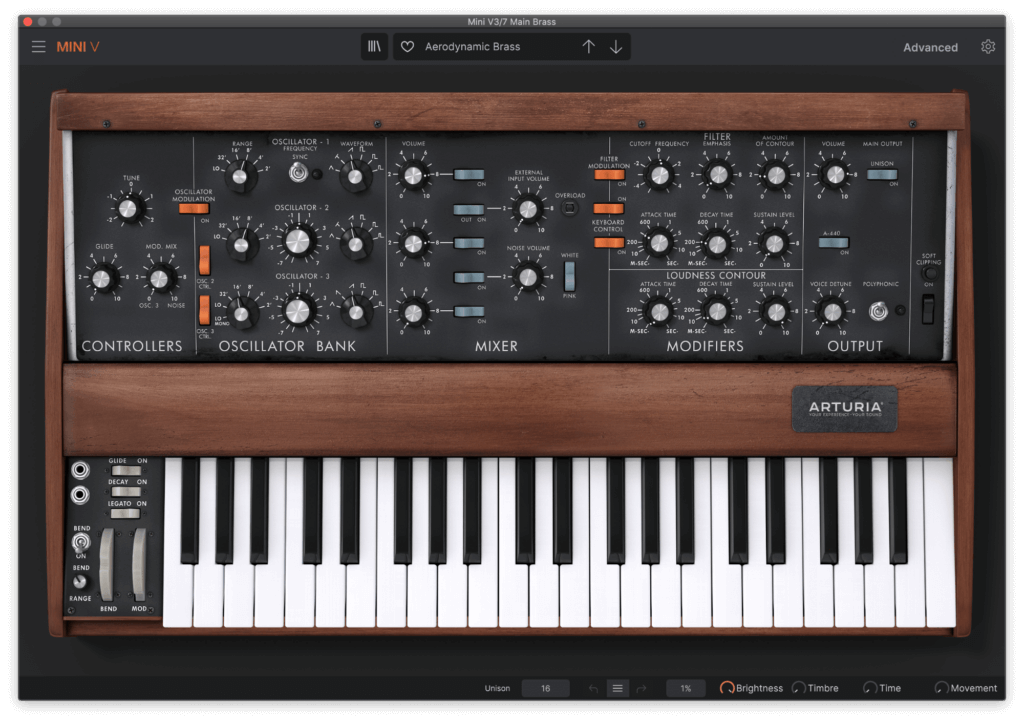
The brass synth sound has some studio magic applied to it. The brass sound is panned heavily to the left and there’s a delayed version of this panned in the centre. This brass sound is then layered with another melody that harmonises the brass by a musical third, very similar to Veridis Quo. The harmony patch is panned hard right, and I used the DX7 patch Harp 2 (the same one I used in Voyager). Here’s what each layer sounds like:
- Brass Mini V 00:00
- DX7 Harp 00:00
- Brass Layered 00:00
One of Daft Punk’s signature sounds plays throughout the Aerodynamic outro: a noisy, screechy wind effect. You can also hear the sound in Aerodynamite, Fall and Contact. The sound is from the Roland Juno-106 and is created by using the noise oscillator with the filter’s resonance pushed up to self-oscillating territory.
In TAL U-NO-LX you can get the same sound with the filter set around 4 and resonance just above 9. Though you can do this on any synth, it sounds extra-special run through the Juno chorus effect. It plays throughout the outro section and can be heard most clearly at the end when all the main synths drop out. In my remake I automated the cutoff point throughout the song, and I’m sure Daft Punk manually tweaked the filter during the recording.
- Aerodynamic Noise 00:00
The snare in this Aerodynamic remake comes from a super simple synth patch I put together in Ableton Analog using white noise with a short decay time. There’s also some slightly EQ and plate reverb to shape the sound. The kick drum and hi-hat sounds are Roland TR-808 samples. The bell sound at the very end is a standard church bell sample pitched down to sound the same as the one in Aerodynamic. Here’s the remake:
Downloads & Related
Thanks for reading! The TAL U-NO-LX and Arturia V Collection patches used for the recreations in this article are available for free download below. If you enjoyed the article then sign up for the email newsletter at the bottom of the page to stay updated on new Daft Punk articles in the future.
Download the Presets
Download the synth presets created for this article here. Alternatively, you can find them in the Synth Sounds Collection, a free download containing all of my free synth presets.
Header artwork by Makarxart




